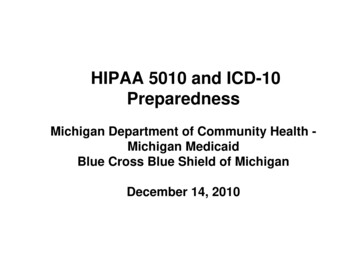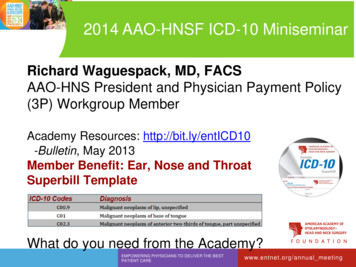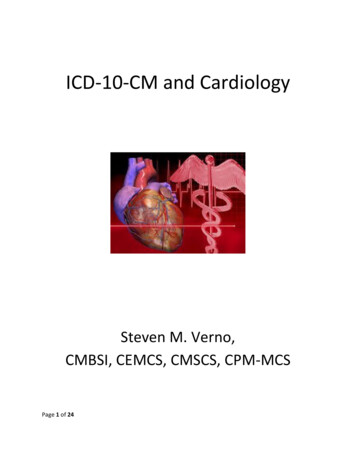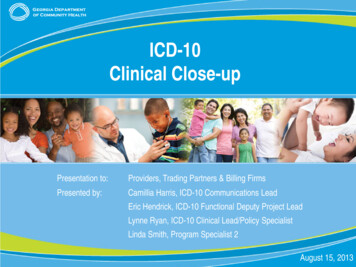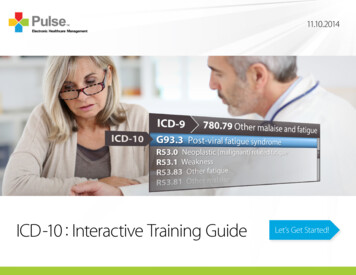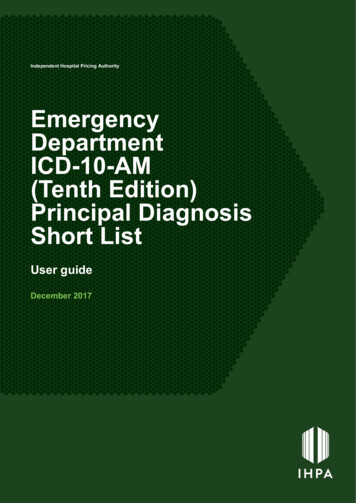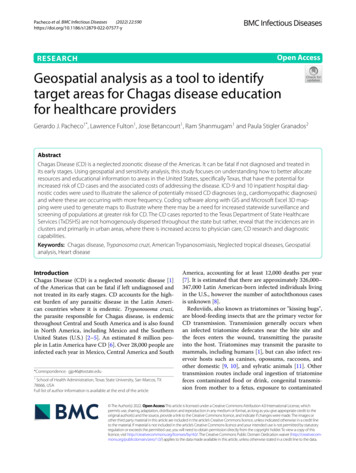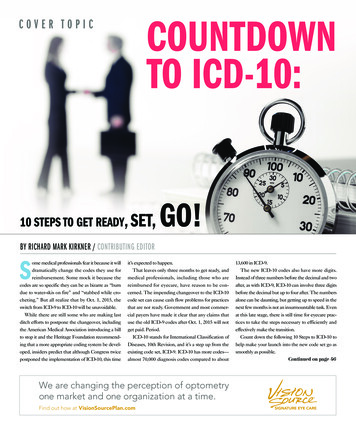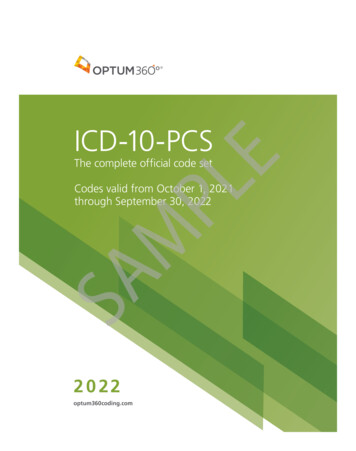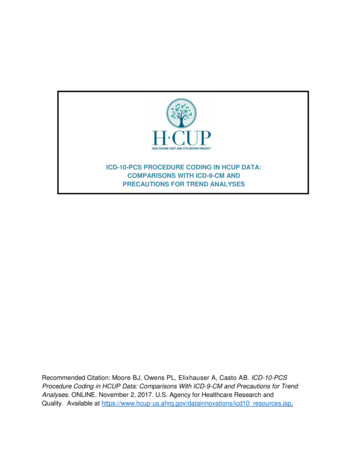
Transcription
Complete Home Health ICD-10-CMDiagnosis Coding Manual, 2016Dear Customer:Thank you for purchasing the 2016 Complete Home Health ICD-10-CM Diagnosis Coding Manual.We are sending you this document so that you can update your 2016 ICD-10 Manual. Note: The changesbelow already have been made online to the Home Health Coding Center website athttp://codingcenter.decisionhealth.com/.CMS released the following updates after the Manual was published: In November 2015, CMS reissued the PPS payment logic (grouper) to award points for “certain”initial encounter codes (7th character A), effective Jan. 1, 2016. There were 1,006 codes with 7thcharacter A added to the case-mix list and 1,095 codes with a 7th character A added to the nonroutine supply (NRS) list. View a compiled list of these codes athttp://decisionhealth.com/pdf/I10Errata.pdf.The following issues were found after the Manual was published:The majority of these are clarifications to coding tips either based on updated Coding Clinic guidance thatwas released after the book was published, or in an effort to provide additional information to help guideyour coding. Tip on E31.2 should read: MEN syndromes are distinct, inherited autosomal disorders, whichmay present in conjunction with endocrine tumors. Disregard the tip at F17.210, and category F10-F19. There is no guidance as of yet on the useof Z72.0. Tip on G10 should read: Huntington's disease is a progressive neurological disorder thatincludes dementia and mental deterioration as part of its progressive course. The alpha indexinstructs to use an additional code (F02-) to identify dementia with or without behavioraldisturbance. Tip on G35 should read: Code G35 should be listed primary when patient is being seen for morethan one aspect of the disease. Code associated symptoms of MS from Chapter 18 after code G35(MS), but only if those symptoms are not routinely associated with MS. Tip on category I05-I09 should read: Categories I05-I09 include disease of the heart valve(s)specified as rheumatic. Disregard the tip at I21 that reads “Home health will always use a 5th digit of 2 ” Thiswas incorrectly carried over from ICD-9. Tip on I73.9 should read: Do not assign I73.9 when peripheral atherosclerosis is reported in theclinical record. Note, atherosclerosis of the extremities is a more specific diagnosis and should becoded using a code from I70.2- through I70.7-. Tip on I87.2 should read: Venous insufficiency may not be severe enough to result in an ulcer.Stasis ulcers are more likely caused by chronic venous hypertension. If the physician documentsonly 'stasis ulcer' then use I87.2 followed by the ulcer code to indicate severity and laterality.
Tip on J43 should read: Codes in the subclassification J43 include respiratory insufficiency,therefore do not assign R06.89 as an additional code.Disregard the tip at J44: This tip was incorrectly based on ICD-9 coding clinic guidance.Tip on J44.1 should read: An acute exacerbation is a worsening or decompensation of a chroniccondition. It is not equivalent to an infection superimposed on a chronic condition. Verifydecompensation with the physician when "end stage" disease is documented.The second tip on J45 (If asthmatic bronchitis ) should read as the following two tips:o Tip 1: Asthma (J45) is the type of asthma also known as reactive airway disease. It is aninflammatory process of the lining of the lungs and is considered reversible. If thedocumentation includes modifiers such as chronic or obstructive, J44.- should be codedinstead of J45.- .o Tip 2: If asthma, sometimes known as reactive airway disease, and chronic obstructiveasthma are both documented, use J44 to indicate the obstructive asthma and theappropriate J45 code to indicate the type (intermittent or persistent) and the severity (mildto severe) of the allergic/nonallergic asthma.Scenarios Chapter 6 scenarios that address late- vs. early-onset Alzheimer's disease: These scenariosshould’ve been clearer and stated that “early or late onset” has to be confirmed by the physician,it cannot be assumed.Chapter 21 scenario “Joint replacement” (p. 1779): The rationale should state that it is bestpractice to be as specific as possible and add a code to identify the joint involved. There are noinstructions in the Tabular to use an additional code.Chapter 21 scenario “Aftercare for circulatory system surgery” (p. 1780): The correctprimary code is Z47.81.Please let me know if you have any questions.Maria TsigasDirector of Product ManagementPost Acute Care GroupDecisionHealthmtsigas@decisionhealth.com
2016 PPS final rule: Case-mix and NRS points awardedto initial encounter codesIn November 2015, CMS reissued the PPS payment logic (grouper) to award points for “certain” initial encountercodes (7th character A), effective Jan. 1, 2016. Below is a list of the 1,006 codes with 7th character A added to thecase-mix list and 1,095 codes with a 7th character A added to the non-routine supply (NRS) list. You can also viewthe CMS’ grouper update at 3AS31.812AS41.042A
616A
S91.225AS98.012AT20.312AT21.30XAT22.252A
T23.232AT23.372AT23.722AT24.312AT24.792AT25.712A
Non-routine S31.140AS31.521AS39.022AS46.222A
S61.241AS61.320AS61.358AS66.128AS68.113A
S88.911AS91.144AS91.321AS98.312AT20.67XA
792A
Complete Home Health ICD-10-CM Diagnosis Coding Manual, 2016 Dear Customer: Thank you for purchasing the 2016 Complete Home Health ICD-10-CM Diagnosis Coding Manual. We are sending you this document so that you can update your 2016 ICD-10 Manual. Note: The changes below already have been made online to the Home Health Coding Center website at

